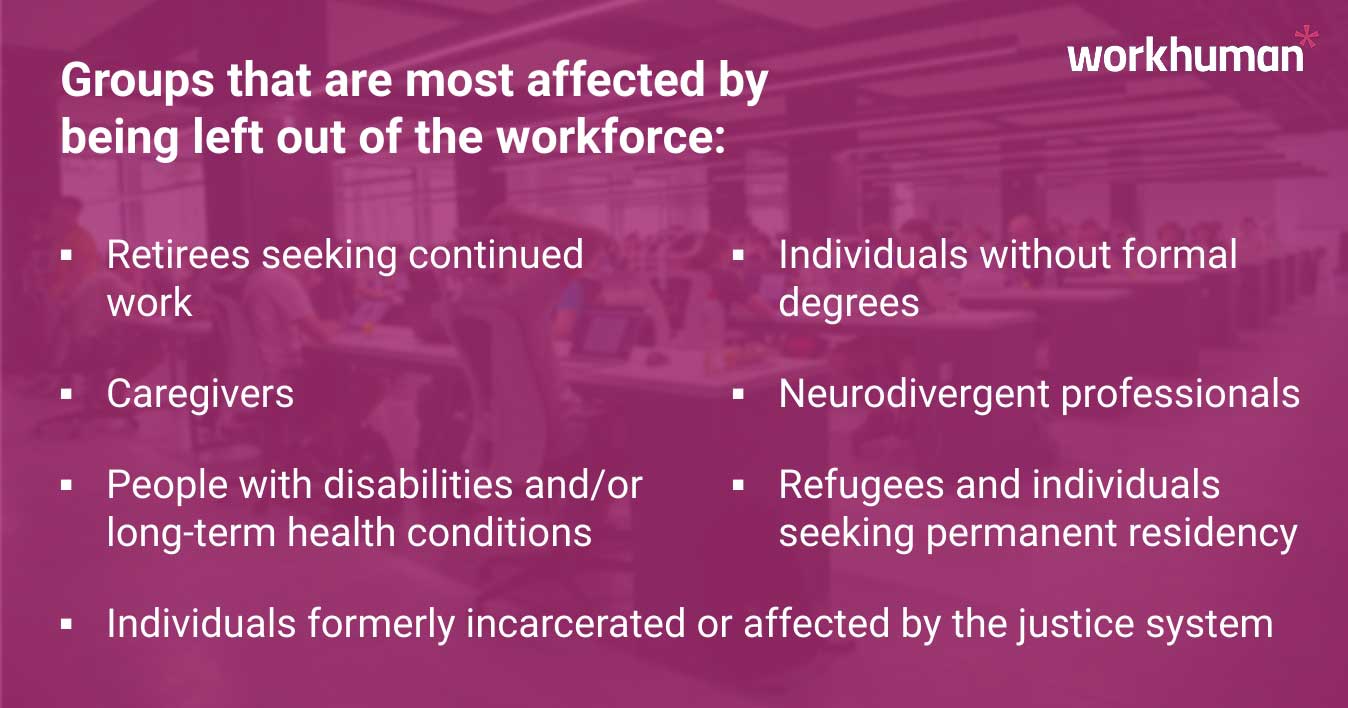How to Recruit and Retain Overlooked Talent

While millions of open positionsOpens in a new tab exist in the U.S., a substantial talent pool remains untapped. An estimated 27 million individuals constitute the "hidden workforce," people actively seeking to re-enter the workforce or contribute more to it. This diverse group encompasses retirees, caregivers, people with disabilities, and individuals without formal degrees.
The solution? Organizations should actively seek out ways to hire and support these workers. It offers a win-win situation for businesses and helps to foster a more inclusive work environment.
Why tapping into the hidden workforce makes business sense
Beyond the economic benefits of filling open positions, companies that purposefully hire hidden workers see an attractive return on investment – they report being 36% less likely to face talent and skills shortages compared to companies that do not hire hidden workers.
Organizations also benefit from the cost-effectiveness that comes with hiring individuals that may require minimal training due to prior experience. Many groups fall under this category like retirees, caregivers, and refugees.
Despite many organizations attempting to make progress on their DEI initiatives, most organizations are struggling to move the needle. Turning to this overlooked talent pool will help reach your goals and create a more inclusive organization.
Many of the individuals in this untapped workforce have lived, or are living, through a different reality than most. Exposure to a diverse range of life experiences and skill sets helps employees foster understanding and empathy. These individuals will do more for your organization than fill an open role – they will deepen and add to your workplace culture.
An overlooked talent pool
Researchers have discovered that hidden workers typically fall into one of three categories:
- An individual is working one or more part-time jobs but could or would like to work full-time. Consider an individual without a formal degree that has only been able to find part-time work.
- A person has been unemployed for a long time but still seeking employment. Think of a caregiver or retiree looking to get back into the workforce.
- An individual that is currently not working nor actively seeking employment but could be working under the right circumstances. Consider someone with a long-term health condition that is intimidated by searching for a new job because past organizations were not supportive.
Let’s learn about the groups that are most affected by being left out of the workforce and how they can enrich your organization.

Retirees seeking continued work
People aren’t just living longer, they are also staying active, and working, later into the average lifespanOpens in a new tab. Unfortunately, many older workers looking to rejoin the workforce tend to face age bias and discrimination and are left un- or underemployed.
Organizations are missing out on strong candidates when filtering for age – with decades of industry expertise, retirees bring a wealth of knowledge and hindsight to the workforce. They are also likely to have a strong, well-connected network and can potentially save the organization money as they’ll require less training to get up-to-speed.
Caregivers
Caregivers provide support and assistance to children, elderly people, or any other person that needs help with daily living activities. Some caregivers step away from full-time work for a period and then re-enter the workforce when their responsibilities lessen, while others just need flexibility around timing to get their jobs done (like parents).
Caregiving requires patience, empathy, and strong attention to detail. These individuals can think on their feet, delegate tasks efficiently, prioritize and manage time, and find innovative solutions to overcome challenges in the workplace.
People with disabilities and/or long-term health conditions
The good news is that the employment rate for people with a disability is higher than it’s ever been, as per the article 'Employment Rate Rising for People with DisabilitiesOpens in a new tab' by SHRM. Economists attribute this rise to remote work, increased flexibility, and advances in technology.
People with disabilities and long-term health conditions possess a range of strengths that can be incredibly valuable in the workplace like perseverance in the face of obstacles, time-management, a strong understanding of technology and the ability to leverage it effectively, and a deep sense of empathy and understanding for others who face challenges.
Neurodivergent professionals
Neurodiversity refers to the idea that the human brain can function in various ways, and these variations are considered natural rather than deficits. Conditions like attention-deficit/ hyperactivity disorder (ADHD), autism spectrum disorder (ASD), dyslexia, and dyspraxia fall under the umbrella of neurodiversity.
Individuals with these conditions often possess unique strengths that make them valuable employees like increased creativity, problem-solving and pattern recognition abilities, sustained focus, and honest and direct communication.
Refugees and individuals seeking permanent residency
Although laws are in place to protect refugees from workplace discrimination, these individuals often face prejudice from employers. To add to the struggle, it’s likely they lack the type of social network where a person can advocate or make connections to job opportunities for them.
Many refugees have overcome significant challenges and bring resilience, grit, and a dedicated work ethic to their jobs. This population is made up of skilled professionals such as doctors, lawyers, and teachers. Many refugees also speak more than one language – a highly desirable skill in workplaces.
Individuals formerly incarcerated or affected by the justice system
Incarceration is a form of rehabilitation – re-entering into the workforce should be viewed as a continuation of the rehabilitation process. Many formerly incarcerated individuals are highly motivated to rebuild their lives and prove themselves, and it’s up to organizations to give them a chance to do that.
Individuals impacted by the justice system possess an array of strengths that can be highly beneficial to employers such as being adept at finding innovative solutions with limited resources, the ability to stay focused and determined in the face of adversity, and commitment to their work.
Individuals without formal degrees
Despite gradual declineOpens in a new tab degree requirements on job postings across all sectors, data showsOpens in a new tab many of these jobs are still going to those with college degrees.
Individuals without a degree can bring a wealth of technical and soft skills to your organization that can be built upon with proper training and support. For example, these individuals may have honed communication and interpersonal skills through customer service experience, prior workplaces, or community involvement.
Practical tips for employers looking to hire and support hidden workers
So, how can your organization begin to tap into this pool of eligible workers? Employers and HR departments will have to first adjust their thinking when it comes to recruitment and support.
Shift away from traditional hiring practices.
When searching for hidden workers, it’s critical to move away from rigid requirements, like formal degrees, and focus on skills and areas of growth. Partner with nonprofits and other advocacy groups to proactively seek out workers who have previously been excluded from your process of recruitment.
Advocacy groups can be a vital source of education for employers who are serious about hiring and supporting candidates from underutilized communities. These groups can help by connecting your organization to a pool of candidates and by acting as a resource during the adjustments of onboarding.
Embrace technology and provide accommodations.
Did you know that most workplace accommodations cost zero dollars ($0) to implement? Offering built-in, flexible accommodation is what makes a job doable for many people in the hidden workforce. It truly makes a world of difference in whether a person can successfully participate, and thrive in a role. Here is a list of baseline accommodations employers should adopt:
- Access to digital tools like screen readers and communication platforms
- Allowing employees to work when, and where, is best for them without formal approval
- Ensuring there are breaks in long meetings
- Setting core hours for meetings
- Making it clear that wellness and mental health breaks are encouraged
Offer equitable development opportunities.
To ensure all employees can grow and thrive, offer skills-based training and personalized development opportunities. It’s likely that many of your new employees will benefit from education on how they can grow their skills and career within the organization and on the health benefits that can assist them and their working style.
Pair employees with a mentor and/or and onboarding buddy that can support them during transitions and everyday challenges.
Conclusion
Here’s the paradox: a significant talent pool remains underutilized despite a labor shortage. It’s up to businesses to actively integrate these neglected groups of workers into their organizations. There’s a massive payoff for society as a whole and the health of your workplace culture and business. What is your organization waiting for?
About the author
Alicyn Zall
Alicyn Zall is a writer dedicated to creating a more equitable and fulfilling workplace. With a focus on actionable, data-driven insights, her work empowers individuals and organizations to foster positive change. In addition to her contribution at Workhuman, Alicyn has served as an editor at Harvard Business Review where she developed books and articles about mental health and the future of work.